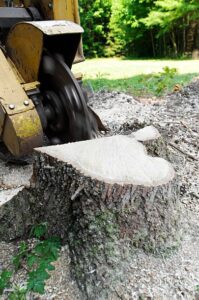A tree lopper is a tool used to cut trees. It can be used to stub out new limbs or reduce the size of a tree. The most basic Black-Stump-Tree-Services tree lopper Adelaide Hills, has scissor-like blades on a long extendable handle, and you use your strength for the cutting action. Other loppers have a ratchet or compound lever system that increases cutting force.
Blade Material
 A good lopper should have a solid blade construction. Look for a blade that is flat with no rough spots or burrs; poor-quality blades often bend slightly, which makes it more difficult to cut through thick branches. The blades should also meet together with a tight fit. Try grabbing the handles and closing them firmly to see how well they hold together; a good pair of loppers will absorb some shock without crushing or breaking. All quality loppers feature a bumper near the blades to prevent the handles from smashing together as you close them. Many have a mechanism that multiplies force, which allows you to cut through thick branches more easily.
A good lopper should have a solid blade construction. Look for a blade that is flat with no rough spots or burrs; poor-quality blades often bend slightly, which makes it more difficult to cut through thick branches. The blades should also meet together with a tight fit. Try grabbing the handles and closing them firmly to see how well they hold together; a good pair of loppers will absorb some shock without crushing or breaking. All quality loppers feature a bumper near the blades to prevent the handles from smashing together as you close them. Many have a mechanism that multiplies force, which allows you to cut through thick branches more easily.
Most loppers come in either bypass or anvil blade styles. Bypass loppers use a single-edged blade that slides past a thick base as they close, making them better for cutting live, green wood. Anvil loppers crush and tear softer greenery, although they are more suitable for dead branches.
Some loppers have an adjustable telescoping handle, which allows you to extend them for additional reach. These are best for reaching high tree branches without using a ladder. They are also helpful for pruning hedges or bushes.
A Teflon coating protects carbon-steel blades from rust and makes them easier to clean after using the tool. It’s important to clean loppers after each use to eliminate sap residue and prevent disease transmission from one plant to another.
The type of Black-Stump-Tree-Services tree lopper Adelaide Hills you choose depends on the thickness of the branches you want to prune. Basic manual models work well on narrow stems and small twigs, while ratcheting and compound-action loppers are designed for thicker branches.
It’s important to prune trees properly. If you let them grow wild and unruly, they can end up putting your house or family in danger. A poorly pruned tree can also become susceptible to insect infestation and other problems.
A professional arborist can help you maintain a healthy, attractive tree that’s safe to enjoy. But you can also perform simple maintenance by keeping your loppers in great shape. It includes regularly sterilising them with isopropyl or ethanol to inhibit disease transfer and cleaning them to remove sap residue after each use. In addition, make sure to dry the loppers and wipe down pivotal parts with mineral or multipurpose oil before storing them to prevent rusting.
Length
A good set of loppers will have a blade between 15- and 36 inches long. The longer loppers offer more leverage and power to cut thicker branches. However, longer handles are heavier and more difficult for smaller hands to hold and operate for extended periods. Consider choosing a pair of loppers with a comfortable, cushioned handle to reduce hand pain and fatigue.
Some loppers have Teflon or titanium coatings to resist rust. These coatings also help to make cleaning the sap residue left on carbon steel blades easier after cutting green tree limbs. These coatings do not protect the blade’s edge from wear, so it will still need regular sharpening to keep it working efficiently.
There are several different types of lopper blades, and they come in either bypass or anvil styles. Bypass loppers are best for healthy foliage and new growth, while anvil loppers are better suited to dead or diseased material. The type of blade you choose will depend on the trees you’re trimming and the size of the branches you need to cut.
Cutting Action
A lopper’s blades are designed to cut quickly and cleanly, often using a compound action to cut through thicker stems. They may also have a curved edge to help guide the blade as it slices through branches. The cutting edge is often coated with a Teflon layer for added strength and durability. Stainless steel blades are typically more corrosion-resistant than those made of carbon steel.
Some Black-Stump-Tree-Services tree lopper Adelaide Hills are basic and only work on narrow branches, while others feature scissor action or even a ratcheting cutter that easily cuts through wood. Longer loppers allow you to reach high branches, while some have extendable handles that you can adjust to increase leverage and reduce hand fatigue. Some loppers are even designed for trimming hedges or shaping topiaries and have two blades that move against each other to trim more branches at once rather than picking them out individually.